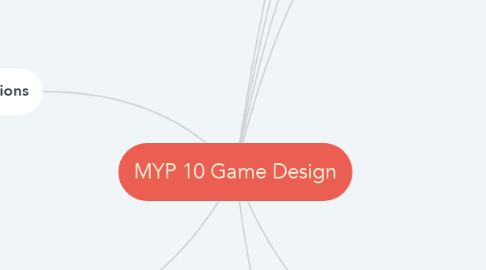MYP 10 Game Design
by Lee Ung


1. Major Resources
1.1. MYP Year 5 Rubric
1.2. Course Calendar Fall 2018
1.3. Discussion Board / Troubleshooting
1.4. C# Reference
1.5. Summative II (Final) Resource Folder
2. Applications
2.1. Unity
2.2. Sketchpad 5.1
2.3. Codecademy
2.4. Screencast-O-Matic
2.5. Code Combat
3. Criterion A: Inquiring and analyzing
3.1. A.i. Explain and justify the need for a solution to a problem for a specified client/target audience
3.2. A.ii. Identify and prioritize primary and secondary research needed to develop a solution to the problem
3.3. A.iii. Analyze a range of existing products that inspire a solution to the problem
3.4. A.iv. Develop a detailed design brief, which summarizes the analysis of relevant research
4. Criterion B: Developing Ideas
4.1. B.i. Develop design specifications, which clearly states the success criteria for the design of a solution
4.2. B.ii Develop a range of feasible design ideas, which can be correctly interpreted by others
4.3. B.iii. Present the chosen design and justify its selection
4.4. B.iv. Develop accurate and detailed planning drawings/diagrams and outline the requirements for the creation of a chosen solution
5. Criterion C: Creating the solution
5.1. C.i. Contruct a logical plan, which describes the efficient use of time and resources, sufficient for peers to be able to follow to create the solution
5.2. C.ii. Demonstrate excellent technical skills when making the solution
5.3. C.iii. Follow the plan to create the solution, which functions as intended
5.4. C.iv. Fully justify changes made to the chosen design and plan when making the solution
5.5. C.v. Present the solution as a whole
6. Criterion D: Evaluating
6.1. D.i. Design detailed and relevant testing methods, which generate data, to measure the success of the solution
6.2. D.ii. Critically evaluate the success of the solution against the design specification
6.3. D.iii. Explain how the solution could be improved
6.4. D.iv. Explain the impact of the solution on the client/target audience
7. Strategies of Coding
7.1. Top-Down Design
7.2. Pseudocode
8. Principles of Coding
8.1. Sequence of Concepts
8.1.1. Action
8.1.2. Event
8.2. Conditional Structures
8.2.1. Decision
8.2.2. Selection

